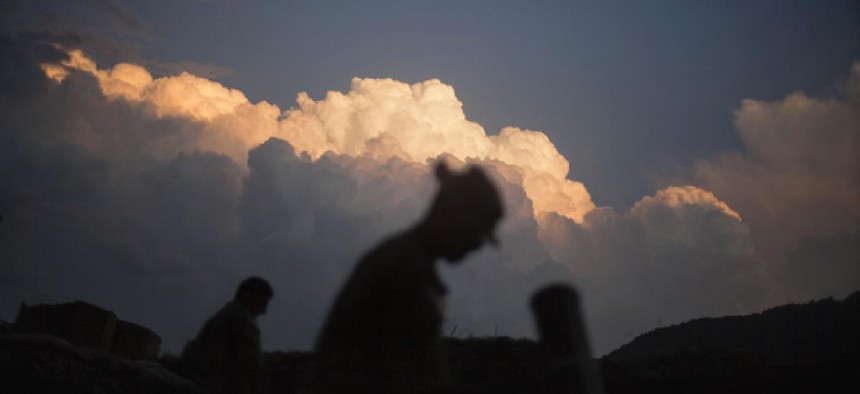Are black women key to easing military suicides?
Veterans Affairs officials hope to learn from culture of social support and encouragement that keeps suicide rates low.
Black women have the lowest rates of suicide in the country, and although it’s not completely understood why, Veterans Affairs officials hope to re-create elements of black female culture that may help stop military veterans from killing themselves.
Women - particularly black women - provide each other social support and encouragement categorized by the opportunity to speak honestly with their peers, said Jan Kemp, mental health director for suicide prevention at the VA.
“The sense of community among themselves, and the ... built-in support that they get from each other is something we’re paying a lot of attention to, and trying to find ways to emulate,” Kemp said. “I think often that veterans and men don’t have that same sort of personal support, and we have to build that for them,” she said.
In general, white men are more likely to commit suicide than people in other groups. The suicide rate among white men was 25.96 per 100,000 from 2005 to 2009, according to the Centerns for Disease Control and Prevention. By comparison, the rate for black women was less than three suicides per 100,000. Government data for suicide deaths among military personnel is not available by race.
Combine that with the stress that the wars in Iraq and Afghanistan have put on troops, and the risk of suicide increases. “We’re working with the highest-risk group in the nation,” Kemp said.
Stories abound of vets dying at their own hands after slipping through the cracks in the care network or not seeking help because of the stigma surrounding mental health issues.
In April, Spc. Rico L. Rawls Jr., 22, reportedly shot himself after he led Georgia State Police on a high-speed car chase. At the time, Rawls was wanted in connection with the shooting death of his wife, Jessica T. Rawls, of South Bend, Ind.
“My son-in-law Rico came back from Iraq a different person. We asked, pleaded, and begged for help for him, but no one listened,” Rawls’s mother-in-law told an Indiana TV station in a written statement. “The pre-Iraq Rico Rawls would not have done this.”
In another case, Kim Ruocco’s husband, John, killed himself in February of 2005 while awaiting a redeployment to Iraq, according to MSNBC. “He was so ashamed of being depressed and not being able to do his job,” Ruocco told MSNBC. She believes her husband was going to seek treatment, but “when he sat there and thought about what it meant to get help, how people who see you, how young Marines viewed him, how his peers viewed him ... he thought the problem was him.”
Kim Ruocco, 49, is now the national director of suicide education and outreach for the Tragedy Assistance Program for Survivors, a group that provides counseling resources for suicide survivors and facilitates support groups for family members. The organization works to provide the social support similar to that prevalent among women -- particularly among black women -- for the loved ones of veterans and active duty personnel who die by suicide or in combat.
“We really try to provide wraparound support,” said TAPS spokeswoman Ami Neiberger-Miller. Surviving family members are paired with peers who have experienced similar loss.
“We give people a place where they can talk and share openly - connect with others who have experienced a similar loss,” Neiberger-Miller said.
The task ahead of groups like TAPS and the VA is daunting. Suicides among active-duty troops are up in the first half of this year, the Associated Press reported Friday.
There were 154 suicides in the first 155 days of 2012, according to AP. That was about 50 percent more than the number of U.S. forces killed in action. Last year, 130 active-duty troops killed themselves over the same period, ending June 3. Veterans are more likely than their civilian counterparts to die by suicide, according to a report published in the American Journal of Public Health earlier this year. About 18 veterans kill themselves every day, according to a Veterans Affairs spokesman.
Of veterans who committed suicide between 2003 and 2008, 92.3 percent were white, according to the American Journal of Public Health. White men made up 85 percent of the nation’s veterans in 2010, according to census numbers.
The VA launched its suicide-prevention program in earnest in 2007, Kemp said. Since then, the crisis line has received more than 600,000 calls and 50,000 contacts via computer chat.
Most contacts result in a referral for an appointment at a nearby VA facility or other services - sometimes just a ride, Kemp said. But more than 25,000 times, VA crisis line call-takers have called police because they believed a vet needed immediate intervention. Perhaps they were holding a gun, had taken pills, or told the call-taker that they could not be saved, Kemp said.
Among the most important VA efforts are those that offer support between peers, she said.
“People need someone to talk to - to bounce things off of, someone who perhaps has been there or knows about being there to provide that layer of hope and understanding that you can pull yourself out of this,” Kemp said. “We can help you pull yourself out of this bad place no matter how you get into that bad place.”
Veterans in crisis and their family members can call 800-273-8255 and press 1 to talk with a VA responder. Help is also available via text at 838255 or at VeteransCrisisline.net.
Families who have lost a service member to combat or suicide can also contact TAPS at 800-959-8277.



